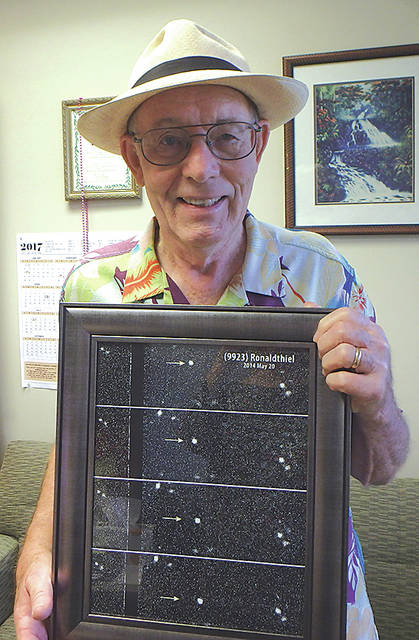Hawaii County Traffic Division chief Ronald Thiel knows lights. Much of his work focuses on keeping local streets safe with streetlights, traffic lights and hazard lights. ADVERTISING Hawaii County Traffic Division chief Ronald Thiel knows lights. Much of his work
Hawaii County Traffic Division chief Ronald Thiel knows lights. Much of his work focuses on keeping local streets safe with streetlights, traffic lights and hazard lights.
He also knows where lights are not helpful — when light pollution interferes with the work of astronomers and the lives of native wildlife. For Thiel’s work preserving “dark skies” in Hawaii County, an asteroid recently was named in his honor — 9923 ronaldthiel.
The asteroid-naming ceremony took place Sept. 28 and was presented by Richard Wainscoat of the University of Hawaii during a meeting of the Mauna Kea User’s Committee in Hilo. The asteroid was first discovered by astronomer Bobby Bus on March 7, 1981, with an orbit of 1,723 days around the sun. It has a diameter of 2.55 miles.
Through the years, Thiel has doggedly pushed for innovation, sometimes going against the flow of traffic. Industry naysayers said it could not be done with light-emitting-diode lamps, so he waited for technology to catch up and he searched for the right manufacturer.
In 2009, the American Recovery and Reinvestment Act made it possible to take small steps with the purchase of the first LED streetlamps. Subsequent county investments and a partnership with the state resulted in the installation of 11,000 LED lamps on county and state roadways throughout Hawaii Island.
The LED lamps support the island’s $58.4 million astronomy industry’s needs for dark skies. Island observatories scan the heavens to improve the understanding of the far reaches of space, including asteroids such as the 9923 ronaldthiel.
The lamps use filters to remove the LED’s blue spectrum, resulting in improved visibility, safer roads and reduced eye fatigue by cutting glare. The filtered lamps also have proven to be far less of an attraction for Hawaii’s endemic threatened and endangered birds and bats.
The highly efficient lamps also reduced electrical and maintenance costs by more than 50 percent, so the new fittings, lamps and installation expenses will pay for themselves in five years. An added benefit is that the LED lamps have a life of 20 years. The low-pressure sodium bulbs they replaced typically lasted just more than four years.




